By Jeffrey A. Rendall, Photos By Kevin Gaydosh and Jeffrey A. Rendall
RICHMOND, VA -- David Malone, Providence Golf Course's Director of Golf, says Golf Architect Lester George has special abilities - and Malone's even got a unique way of describing them: "He's a great designer in all aspects of course architecture, but his ability to route a course is really where he excels."
"He'll take all the available space and fit the golf course in places you wouldn't have thought possible. Here, he left very little unused room, even for our clubhouse. He'll build in every corner -- he's like 'Rain Man' when it comes to maximizing length and breadth," Malone continued.
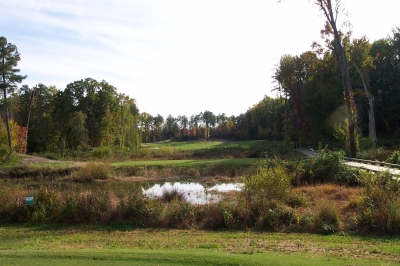 |
| The most intimidating tee shot on the course comes at the 409 yard third hole. If you want to find your ball, hit to the right. |
Rain Man?
Though it's hardly clear whether being compared to an autistic genius is truly a compliment, it's easy to infer exactly what Malone meant in referring to George's extraordinary talents. Providence Golf Course, which opened in May of 2002, certainly takes advantage of its property's space, and true to Malone's word, every nook and cranny is effectively utilized.
Part of the reason for such spatial frugality at Providence was due to the property's history. Half of the course occupies land that was once Pocoshock Creek Golf Course, which closed its doors in 1986. The former Pocoshock contained 18 holes on 100 acres, and squeezed in 5000 yards worth of golf on a pretty teeny bit of earth.
The land subsequently changed hands a few times before developer George B. Sowers Jr. (goes by Buddy) bought it, intending to turn the acreage into a housing development. Sowers then acquired additional land adjacent to the old golf course site, and George convinced him to build a golf course on the property -- leaving room for some real estate development. Though we're yet to see the houses, there's little doubt the golf course has been a smashing success since its opening (it was nominated by Golf Digest's Ron Whitten for 'Best New Public (Affordable) for 2002').
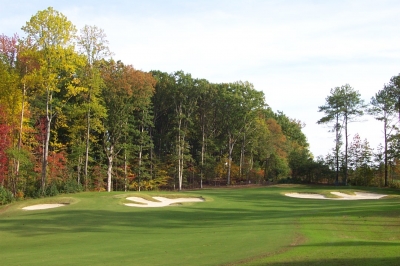 |
| Once over the wetlands, the third green presents an approachable, pleasant sight. |
George tells the story: "There's very little relationship between what you see today at Providence, to the old Pocoshock course. Pocoshock was built in the early 60's, with virtually no irrigation, and was just a flat, featureless muni, essentially. In 1986, I was working as an apprentice for Golf Services International (a west coast architectural firm), and I was there when Pocoshock closed down. So I had some personal interests in bringing it back to life in a new and improved form."
"Basically, the only connection between the old and the new is the land itself, and even that's just a simple tie-in, because Pocoshock's eighteen holes were crammed into the space where holes one, two, three's tee boxes, nine's green, and the back nine are today. The balance of the front nine's holes are on the new portion of the land, separated by the creek which divides the property," George said.
He continues, "We did keep the specimen trees on the old portion of the property, and for that reason, Providence has a very settled look for a course that just opened up this year."
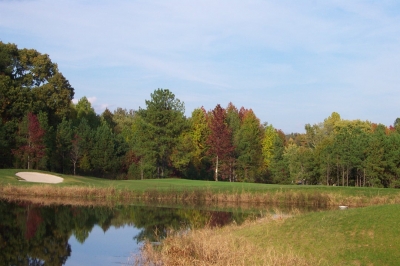 |
| Looking towards the eighth green, how much water you'll have to go over depends on how far to the right you place your second shot. |
Those trees on the course are more than just beautiful, they're prominently incorporated into the design. George explains his fondness for arboreal inclusions: "The trees at Providence are all edge trees that were out in the middle of fairways twenty years ago. They were flourishing on their own, and very hearty because they had thicker bark and weren't really bunched together haphazardly in the woods. So it was easy to keep them."
"I wouldn't necessarily say I try to prominently feature trees in my designs, but on every golf course I've ever designed, there are always a few specimen trees I try to protect, because they add variety to a hole. I won't typically put them in the middle of fairways, but I like to set 'em off on the corners and go behind them with the clearing to try and make them standout," George added.
A good example of George's use of trees is the twelfth hole, a 553 yard par five that doglegs right off the tee, then left towards the green. As is typical at Providence, there's plenty of room to hit your tee ball, but the second shot will present some options - mainly because there are two large trees guarding the layup area, and also the direct approach to the green. Without the trees, it's a much easier trek to the green, though there are some wetlands to be carried.
Just by seeing the course, you'll realize this isn't your average affordable facility. David Malone says the reasonable fees will bring you out, but the layout's quality will bring you back: "Here at Providence, you've got an affordable, daily fee course that gives the guy who's paying $35 (weekdays, riding) the chance to play a truly interesting, well designed course. Most courses in a similar price range don't provide nearly the design integrity you'll find here, where good shots are rewarded, there are interesting shot values, and built in risk-reward situations."
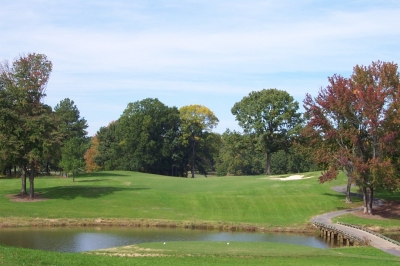 |
| Tee box views of the 12th hole -- challenge the bunker on the right side in order to give yourself the best angle for a layup or a try at the green. |
"I think that's the main reason we've been overwhelmed with play since opening day, and they keep coming back. Over a period of time players, realize there are no bad holes here, it's not tricked up, it's well thought out, and well designed. You generally don't find many $2.4 million daily fee golf courses with this kind of design integrity. So there's value built into the experience," Malone said.
Both Malone and George said it was incredibly difficult to fit a modern, championship layout onto land that was anything but that for many years: "Many people have said, including Vinny (Giles, his design partner at Kinloch Golf Club), that planning the routing was probably harder at Providence than it was at Kinloch, in terms of how to figure out the puzzle. It was a very, very tight fit, because it was such a landlocked site and had so many constraints with wetlands and resource protection areas," George said.
Though the excellence in design is apparent throughout the eighteen holes, it's still obvious that Providence is brand new, in terms of conditioning. The fairways were sodded in 419 Bermuda, and are as good as you'll find anywhere. But the rough areas are still a bit on the 'rough' side. Given time and perhaps another season for grow-in, that problem should take care of itself.
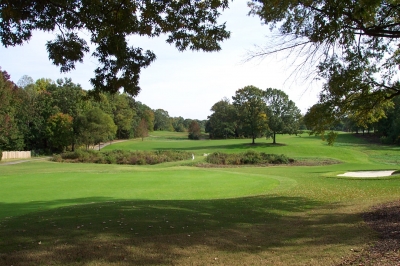 |
| Glancing back from the green at the 12th hole, you'll see the two trees you must avoid to safely reach the putting surface. |
The fact you have sod fairways on a small budget project is another feature unique to Providence. George explains: "We moved an incredibly small amount of dirt at Providence, 80,000 cubic yards (50,000 of that was taken to create four ponds). It was a budget consideration, but it also allowed the owner to sod the fairways. It's hardly typical to put in $450-$500,000 in sod when you're talking about a daily fee, affordable golf course."
Looking at the course, you'll find fairly wide-open views on the older portion of the property, and some tighter, woods lined parkland style holes on the brand new holes on the front nine. Despite the contrast in appearances, there's a seamless continuity in the routing (which certainly has led to Providence's nomination for 'Best New' awards).
Malone speaks of the challenge: "Overall, I wouldn't say the course is difficult for the average player, except for maybe the carries on the third and ninth holes - and both of those are within, or well below, architectural standards and guidelines. We put a lot of thought into tee locations and distances with the average player in mind."
"But from the back tees, the better players will face a reasonable challenge, and the scorecard yardage is a bit deceiving. Our slope rating from the tips is 133, which is pretty high for a course that measures just over 6500 yards. Take out the two short par threes (2 and 17), and factor in that it's a par 71, and there's plenty of yardage to challenge people," Malone adds.
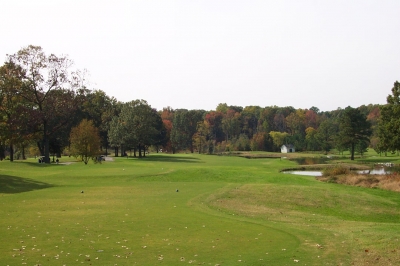 |
| Avoid the water along the right side of the 13th hole -- but trees block the approach if you pull it too far left. |
"The early rap on the course was that it was too short, but we played 5,000 rounds before we had an under par score. But at the same time, seniors, ladies and high handicappers love the course. We can accommodate all skill levels, and the tee box positions will lend themselves towards a fair, equitable and fun layout," Malone said.
One of the more difficult carries Malone alluded to is the tee shot on the third hole. From the back tees, you'll notice a full wetland carry, with an opening on the right side of the fairway and a bunker long and left. Though hardly blind, what's not immediately apparent is the depth of the wetlands on the left side, for those who might try to shave off some distance on the slight dogleg left. Take the safe right side, and tame the most difficult tee shot on the course.
Eight is probably the most spectacular hole on the course. A 525 yard par five, on the tee shot you'll have to avoid a lake on the left side and woods to the right. The lake juts in slightly from the left side with your layup shot, but there's plenty of room to the right. For those going at the green in two, it's almost a full water carry. Good luck.
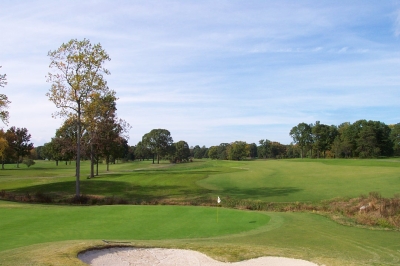 |
| There's little doubt it's a postcard quality view looking back at the 18th green and the wide-open nature of Providence Golf Course. |
Making the turn, the back nine's two par fives are great holes. The twelfth hole is described above, and the round concludes with a 517 yarder that's definitely reachable if you get good distance off the tee. Here again, you'll have to fly it the complete distance if you go at it in two, as wetlands guard the entire short approach.
Finishing up, you won't be able to enjoy a cool one at Providence until the clubhouse is completed early next year (and the club qualifies for a liquor license). But that doesn't spoil the enjoyment you'll already feel from making the rounds at Providence Golf Course - 'Rain Man' Lester George's cleverly routed paradise.
Details:
Providence Golf Course
1160 South Providence Road
Richmond, VA 23236
Phone: (804) 276-1865
FAX: (804) 276-1866
Course Designer: Lester George
Head Golf Professional: John Stone
Director of Golf: David J. Malone
Owner: Buddy Sowers
| Tees | Yardage/Slope | Rating |
| Gold Tees | 6529/133 | 71.4 |
| Blue Tees | 6151/123 | 69.4 |
| White Tees | 5601/115 | 66.6 |
| Red Tees | 5006/116 | 68.1 |
Rates: In season, $22.50 (Walking), $35 w/cart. Weekends $45 (includes cart). Twilight, Senior and Junior rates available.
Notes: Fee for range balls; Unrestricted walking Monday - Thursday. Call for directions.
| Related Links | Comments on this article? | |
|
Maryland National Golf Club Hollow Creek Golf Club Rocky Gap Resort PB Dye Golf Club in Ijamsville Whiskey Creek Golf Club |
E-mail Jeff Rendall, Editor: jrendall@golftheunitedstates.com |











